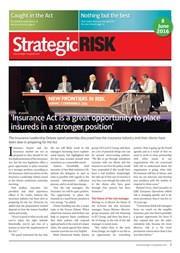Insurers say innovation is critical to their industry, but Airmic members say they aren’t seeing enough of it

Airmic has published a report on innovation in the insurance market.
The association decided to investigate the topic after comments from insurers who say innovation is of the utmost importance. Airmic members, meanwhile, have said they are not seeing enough innovation in the insurance industry.
Ahead of the report’s publication, its author Georgina Oakes, research and development manager at Airmic, told StrategicRISK: “We wanted to delve a bit deeper into what insurers are doing to back up their claims and to understand why our members are saying they are not seeing the innovation that the insurers are saying is so critical.”
For Innovation in the Insurance Industry, Airmic questioned its members on their exposures to cyber risk, reputational risk, supply chain risk and non-damage business interruption. In its annual member survey, these come up as key risk concerns – but at the same time, risk managers tend to not insure them, at least not to the degree they insure more classical exposures like property damage or natural catastrophe.
To find out why this is, Airmic asked just over 100 of its members how innovative they believe the insurance market is, ranking the market between 1 and 5. The average outcome was 2.5, though responses varied significantly, with some members saying the industry is very innovative and others denying it is innovative at all.
The report found that those who didn’t think the market was innovative haven’t bought cover for those risks, while those who do think the market is innovative have bought covers. Furthermore, the risk managers who hadn’t bought insurance had usually been offered a product but felt it was too expensive.
Airmic then interviewed insurance companies to understand their views on innovation. According to the insurers, one of the best ways to ensure a product is innovative and relevant is when the client has a specific request, say for a particular weather risk such as an ash cloud.
“If you can get the client, the insurer and the broker in the room together and really dig deep into the forces that drive the client’s business, the profit streams and what might disrupt those profit streams, then you tend to produce something that’s really relevant and really spot on for the member,” Oakes explains.
In order to achieve this, insureds need to be a lot more open about their business, use their broker to really understand the business, meet with the underwriter far more regularly and share lots more data with them, the report suggests.
“In these cases, it is so critical that the brokers are good at risk consulting and risk advice. They can help open up the business to the underwriters. A lot more time and investment needs to go into this and the broker will need to be aware that their role here will focus firmly on risk consulting and risk advice before going into the placement piece,” Oakes says.
The report aims to get Airmic members to think slightly differently about their insurance placement. Oakes says risk managers should challenge their broker to bring them to the table with the underwriter.
“Risk managers are not going to be able to get these innovative covers unless they are willing to be far more open about their business and discuss this with the underwriter, bring the underwriter to their business, get them to meet the finance team, get them to meet the IT team and so on, so they can understand the exposures as well as the risk manager can.”




















No comments yet